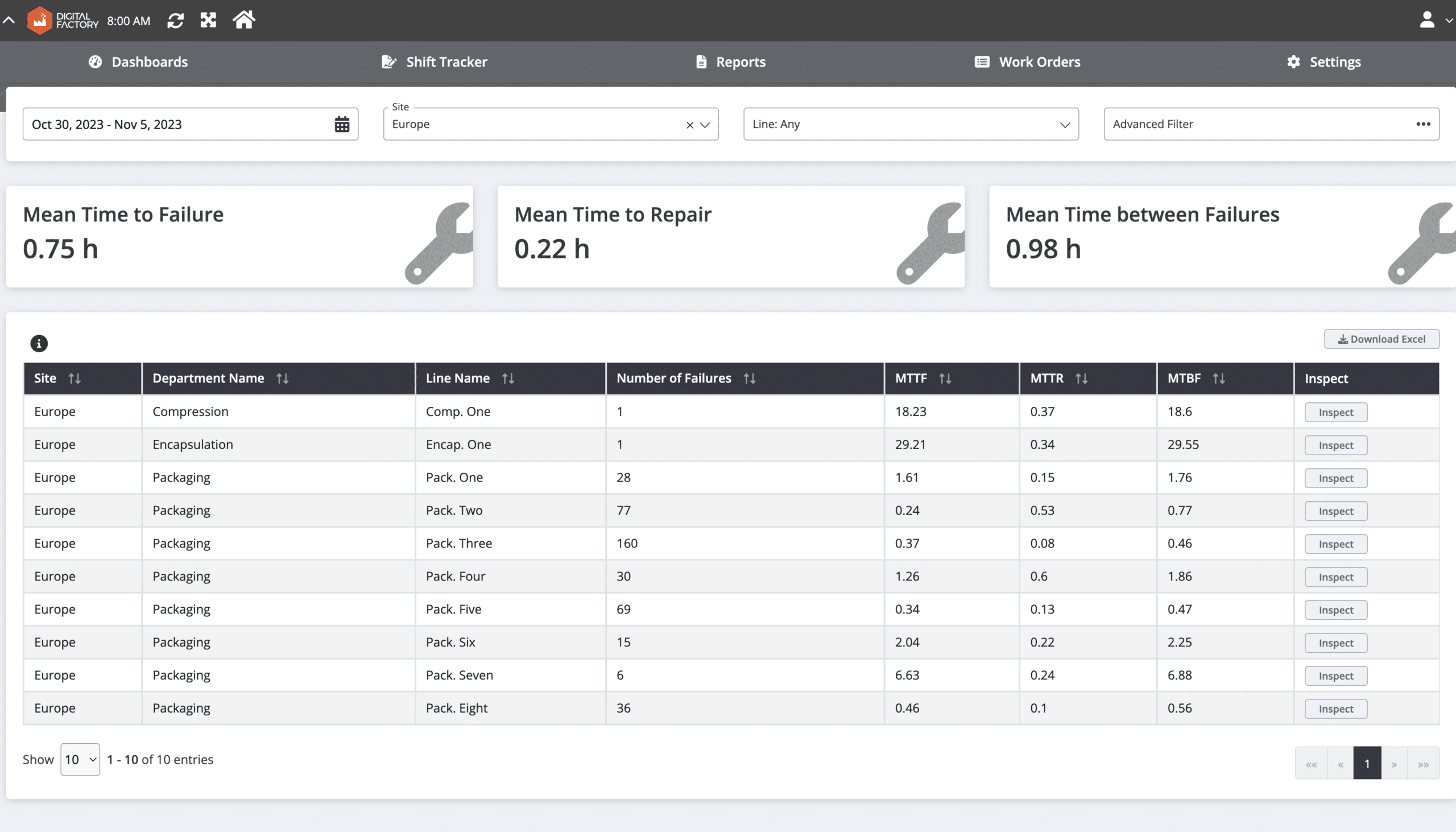According to the Boston Consulting Group, since the COVID-19 pandemic manufacturers are hedging against supply chain disruptions and volatile demand by holding excess inventory and investing in additional capacity. While this reactionary approach may provide some short-term relief, it is ultimately inefficient and costly.
Line balancing offers a powerful alternative. This strategy empowers manufacturing leaders to deliver goods on time to customers without sacrificing overall equipment effectiveness (OEE). This comprehensive guide dives deep into line balancing, exploring its business benefits, outlining practical steps for achieving a balanced production line, and introducing digital lean concepts to maximize value generation.

What is Line Balancing
Production line balancing involves strategically assigning the optimal number of workers and machines to complete work orders efficiently and on schedule. The primary goal is to minimize idle time and unplanned/planned downtime, thereby reducing the waiting waste associated with Lean Six Sigma principles.
Since line balancing considers both adherence to production schedules and overall production efficiency, it directly relates to takt time -rate at which individual units must be produced to meet customer demand on time-. A perfectly balanced production line achieves a takt time ratio of 1:1, meaning the actual takt time equals the planned takt time. Conversely, any deviations from this ideal ratio indicate a need for line balancing. In such cases, resources should be reallocated to optimize production.
Top 5 Benefits of Line Balancing

1. Improve Lean Manufacturing Practices
Line balancing is a method aimed at reducing waste from waiting times and excess inventory in lean manufacturing.
Firstly, assembly line balancing optimizes the synchronization of stations and labor. As a result, work order management becomes smoother, and the waiting time for subsequent tasks is reduced. For example, setting up the line for a specific work order should occur before running the work order, through line balancing no workers remain idle and they complete tasks in a planned way.
Secondly, since line balancing is aligned with takt time, it supports just-in-time (JIT) delivery. Consequently, manufacturers are not required to hold excess inventory.
2. Increase Labor Productivity
By ensuring even workloads and eliminating idle time, line balancing enables workers to maximize their output. This means that workers are not paid for standing idle, and the costs associated with overtime labor are reduced, as line balancing achieves equilibrium between excess work and downtime.
As a result, manufacturers can prevent operator burnout and promote sustainable high performance among workers.
3. Reduce OTIF Penalties
According to Forbes, On-Time In-Full (OTIF) penalties for a medium-sized manufacturer cost over $300,000 on average, negatively impacting company profitability. Line balancing helps ensure products are delivered on time and complete, minimizing the possibility of receiving penalties.

4. Improve Production Quality
To enhance line balancing, factories must standardize workflows. This ensures that every operator, supervisor, and executive has clear directives and Standard Operating Procedures (SOPs) outlining their responsibilities. Standardization leads to a reduction in production deviations, ultimately improving production quality.
5. Increase Manufacturer's Resilience for Demand Shocks
A perfectly balanced assembly line, with a 1:1 ratio of actual to planned takt time, offers greater flexibility when faced with surges in demand. When customer orders increase in quantity, manufacturers can recalculate the takt time to meet the new demand. This revised takt time can then be used to adjust task allocation, ensuring shop floors meet the higher demand via increasing OEE.
To learn more about agile manufacturing you can read our Agile Manufacturing: A Strategy for Longevity in Industrial Organizations article.
How to Balance a Production Line in 6 Steps

1. Utilize Takt Time as a KPI
Line balancing entails aligning the production rate or actual takt time with the planned takt time. In this regard, the first step in balancing production lines depends on using takt time as a key performance indicator (KPI).
To effectively utilize it, manufacturers require a dashboard that compares real-time production with the takt time or target production. This allows executives to take action when the production rate is either slower or faster than the ideal speed.
For example, the image below illustrates SCW.AI’s Daily Production Performance Report, designed to facilitate real-time decision-making for line balancing by monitoring production performance. As depicted, as of 12:00, the actual production speed exceeds the target rate. Consequently, executives can allocate some operators or machines of this line to proceed with other work orders, without compromising just-in-time delivery of production.
2. Improve Your Master Data
To accurately compare actual and target production or takt time, manufacturers must first ensure they have high-quality master data. This data assists scheduling managers in forecasting the precise end dates of work orders by considering factors such as:
- Machine speeds
- Planned downtimes for maintenance activities and changeover
- Expected unplanned downtime durations
- The impact of micro-stops
- Potential labor-related losses and more.
One effective method for improving master data is to conduct time studies. These studies determine the duration required for staff to complete a work order with a specific quantity on a particular line. IoT devices with PLC integration can streamline the collection of high-quality data for these time studies. Additionally, as highlighted by McKinsey, digital twins can be a game-changing technology for manufacturers seeking to enhance the quality of their master data. Time series analysis can be processed through digital twins, enabling manufacturers to establish realistic due dates for each work order.
To find out more AI use cases for manufacturers you can read our related article.
3. Analyze Actual and Planned Production Phase Durations
To ensure maximum line productivity, manufacturers must focus on minimizing both unplanned and planned downtime. Identifying bottlenecks, whether caused by machine setup, line cleaning, or runtime activities, is crucial. Once bottlenecks are identified, corrective actions can be implemented to address them.
Data analysis plays a critical role in this process. As illustrated in the image (not shown), reports can reveal variances between planned and actual phase durations. This information empowers executives to pinpoint the phases where the factory experiences the most significant time losses.
4. Identify and Solve Equipment Bottlenecks
4.1 Identify Equipment Bottlenecks
Losses during the runtime phase can often be attributed to equipment-related issues. Here are some common culprits:
- Equipment failures: These unplanned downtime events directly slow down actual production.
- Microstops: Brief production pauses may seem insignificant, but frequent microstops can accumulate and create substantial losses.
- Performance degradation: Machines that are not operating at peak efficiency can lead to speed losses.
- Scrap production: Degraded machine performance can also result in the creation of unusable scrap (quality losses), further impacting performance.
To determine the root cause of line imbalance in your factory, manufacturers can utilize reports like OEE Waterfall Analysis. This analysis breaks down losses into categories such as quality losses, speed losses, and unplanned losses for selected lines, helping pinpoint equipment related issues.

Manufacturers can leverage maintenance performance reports to pinpoint equipment that are frequently down . By analyzing key metrics like mean time to failure (MTTF), mean time to repair (MTTR), and mean time between failures (MTBF), executives can make informed decisions about equipment maintenance strategies or might decide to replace equipment.

4.2 Solve Equipment Bottlenecks
Machine learning-driven predictive maintenance offers a powerful strategy for extending equipment lifespan. According to Deloitte, this approach can increase equipment availability by 10% to 20%, while simultaneously reducing maintenance costs.
5. Identify and Solve Labor Inefficiencies
5.1 Identify Labor Inefficiencies
Labor inefficiencies can contribute to various types of losses, including unplanned downtime, planned downtime, performance losses, and quality losses. Waterfall analysis, therefore, has the potential to identify areas where labor inefficiencies are impacting production.
To analyze labor performance in greater detail, manufacturers can utilize labor performance reports. These reports provide valuable insights into various aspects of worker activity, including:
- Individual work hours: Track the total hours worked by each worker.
- Process variances: Identify deviations from standard times for tasks like machine setup, line cleaning, and runtime activities.
- Work allocation: See which lines and work orders each worker is assigned to.
- Product performance: Analyze worker performance on specific products.
- Shift performance: Compare worker performance across different shifts.

5.2 Solve Labor Inefficiencies
To improve the return on labor and achieve optimal line balancing, customized training programs tailored to each worker’s existing skill set are crucial. Digital twins offer a powerful tool to facilitate this training by providing realistic simulations.
Similar to pilot training sessions, digital twins allow operators and supervisors to practice using equipment effectively in a simulated environment. This eliminates the risk of errors or damage during actual production runs.
6. Allocate Work Orders with APS Software
A manufacturer’s ability to achieve high shop floor effectiveness hinges on efficient job shop scheduling. Today, AI-driven Advanced Planning and Scheduling (APS) systems are revolutionizing work order allocation. These systems consider various objectives – just-in-time delivery, minimizing changeovers, maximizing OTIF (On-Time In-Full) performance, and more – to automate job assignments to production lines.
According to the Boston Consulting Group, AI-powered schedulers are useful investment tools for manufacturers. AI Schedulers empower manufacturers to react swiftly to demand fluctuations and can achieve an OEE increase of over 3% by implementing such systems.

How Can SCW.AI Assist Manufacturers in Production Line Balancing
SCW.AI’s Digital Factory Platform equips manufacturers with a comprehensive suite of cloud tools to optimize line balancing and achieve peak production efficiency. Here’s how:
- Daily Performance Report: This report provides a clear comparison of actual versus target production for each line and work order, incorporating augmented takt time for real-time insights.
- OEE Waterfall Analysis: Identify bottlenecks within your production process through detailed visualization of losses associated with specific phases.
- Maintenance Performance Report: Gain valuable data on equipment health to proactively schedule maintenance and minimize downtime.
- Labor Performance Report: Analyze worker activity to identify areas for training and optimization.
- IoT Hub: Automate data collection from your shop floor, eliminating manual data entry and ensuring real-time visibility.
- AI Scheduler: Leverage the power of AI algorithms to automate task allocation and achieve optimal production scheduling.
If you have further information regarding line balancing you can contact with us.
To discover the full potential of Digital Factory Platform you can book a demo with us now.




